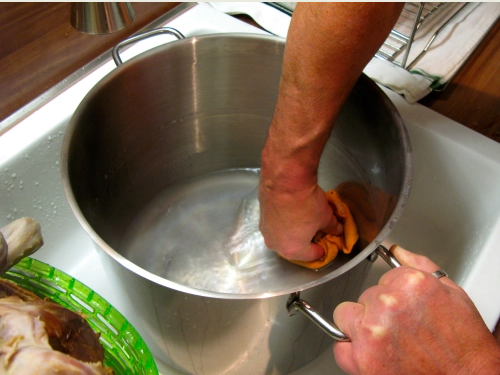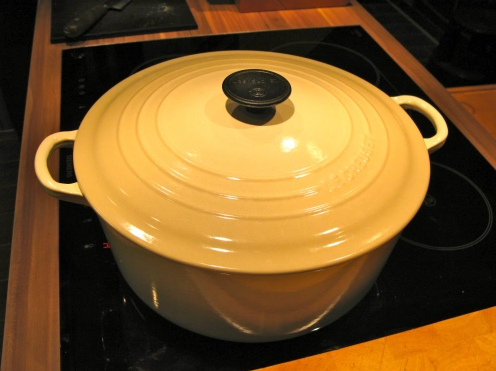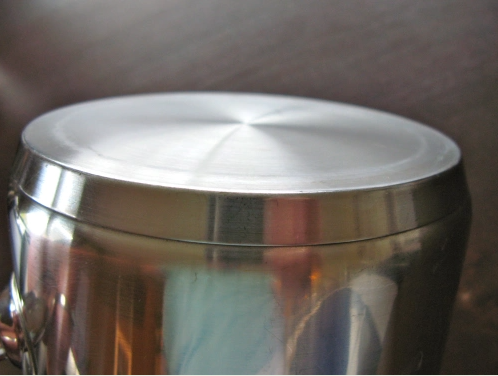Why do pots in this country usually have 2 handles? In the kitchen you usually always have at least two hands too few….with such a bucket (for cooking stock) it is appropriate, because with a weight of 15 to 17 kilos you need two hands to carry the thing.
‘Normal’ saucepans always have 2 handles. At best, you get a 16 cm saucepan – the French and the English probably understood that better somehow, because there are saucepans in all sizes (only the tall ones are relatively rare). This is probably due to the fact that a lot of cooking is done with gas. The short side handles get hot when cooking on a larger flame. And if they are made of plastic, then they also char…:(
For me, the best pot has a long handle. Except for the large bucket for stock and the casserole (which is made of cast iron and already weighs 6 kg empty). Basta!
Someone recently said ‘professional stuff’ – that’s partly true. Such pots are also available in specialist catering trade in Germany, but they are rarely found in domestic kitchens. Why don’t we take such pots at home when the professionals show us how to do it? Ah yes, they are not advertised, although they have quite significant advantages (not just the long handle).
Such pots are made for tough, daily use in professional kitchens. The material is 0.7 or 0.8 mm stainless steel…no, not ’18/10′!!! Let’s be honest: how many ‘pot owners’ out of a hundred know what ’18/10′ is? And 18/8? And 18/0? And D11?
Different steel qualities! 18/10 is probably the biggest myth – what is often advertised as 18/10 in this country is a chrome/nickel stainless steel with the international designation AISI 304. The chrome content is about 18%, the nickel content 8%. For this reason, many cooking pot manufacturers have started to show ’18/8′ in recent years. There is probably a steel quality with 10% nickel content, but nobody could afford that for cooking pots.
What is the purpose of nickel in steel for cooking pots? Aren’t there concerns about nickel allergies?
Well, nickel makes the steel ‘stainless’. But even a pot made of nickel-free steel will not rust if it is not placed in a wet cupboard. Incidentally, every induction-suitable pot has a base (capsule or plate) made of nickel-free steel. Nickel also has the property of making steel anti-magnetic and the pot would therefore not work according to the induction principle.
But…but….and…how now…?
This article could become a small book, but I will focus on the essentials:
The material strength of the steel is decisive for a good pot – not the nickel content. A wall thickness of at least 0.7 mm is an indicator of good, long-lasting quality. Wall thicknesses of more than 0.8 mm are probably on the market, but completely unnecessary and expensive.
The floor should be an encapsulated sandwich floor (steel-aluminum-steel). Here, the thickness of the floor is often cited as a quality feature – the thicker, the better (heat storage capacity). This is nonsense (and contradicts the trend towards induction stoves, which have one of the characteristics of gas stoves: energy = heat immediately, energy off = heat off)! Who needs a base that stores so much heat that the reduced sauce crusts on the base when I’ve already turned off the heat? 3 mm aluminum is completely sufficient in a sandwich floor! What’s important is the manufacturing process: many (most, to be honest) sandwich/capsule bottoms are soldered. The aluminum plate is connected to the pot (inner) base and the end plate/capsule using heat and a ‘connecting solder’. This usually results in minor voids, which are not desirable. A forged sandwich base is forged onto the pot using a high-pressure friction press. Due to the enormous pressure of at least 1,600 tons, the aluminum liquefies and combines with the steel without any cavities. A forged base deforms less when heated, which means less energy loss when cooking.
The lid: Have you ever read advertising slogans such as ‘glass lids for cooking on sight’? What, if you please, is ‘sight cooking’??? A stainless steel pot needs a well-fitting stainless steel lid that closes as tightly as possible! It can also be a bit heavier (at least the material thickness of the pot, or up to 0.3 mm thicker), the tighter it closes. In addition, glass lids tend to break (this can get ugly, especially in the oven if the glass part has not been perfectly hardened and bursts into thousands of pieces at 180°C – goodbye Sunday roast!).
Post time: Nov-15-2022







